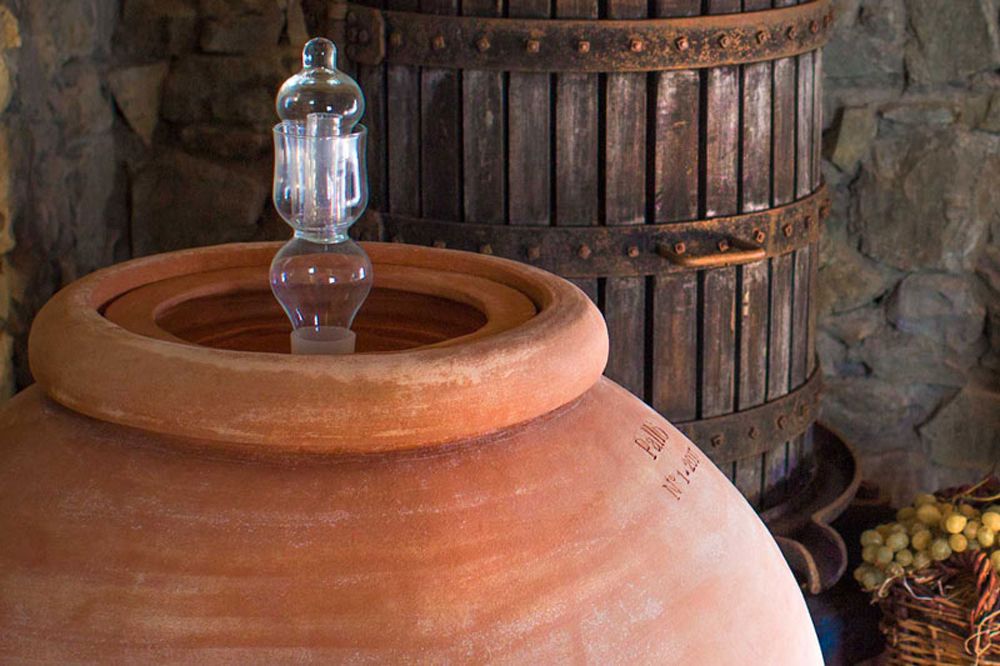
Wine amphorae
In 1871 Giuseppe Verde, one of the most famous people from the Parma area, wrote, “Let’s go back to the past, it will be progress”. Who knows if Tenute-Venturini Foschi, founded in those very same lands (only a little further south), might have had this phrase in mind when they decided to use terracotta amphorae for the vinification of their Gemma Gentile.
Yes, because the use of terracotta amphorae for fermenting and refining wine is very old and it is surprising that in recent years, after the development of innovative machines and technologies for winemaking, many wineries have returned to such a simple and essential natural container.
With an eye on history, many producers have realised that a return to their origins, reworked in a modern style, could be a step towards the future. In particular, they study the Georgian tradition where wine-making in amphorae called qvevri began 8,000 years ago and has never really gone out of fashion. This method has been on the UNESCO Intangible Cultural Heritage List since 2013.
Terracotta amphorae for wine-making
On closer inspection, the return is more than worthwhile and finds justification in the numerous advantages offered by these age-old containers. First of all, terracotta is porous, a characteristic that allows a natural micro-oxygenation of the wine during the refining process equal to that of wood but without the release of aromas and tannins from the latter.
While barrels and barriques impart aromas to the wine, terracotta is an inert material that in no way alters the wine’s aroma and preserves its sensory profile.
This characteristic makes amphorae an optimal container for those producers who want to enhance the varietal character of the vine and let the characteristics of the grapes and the terroir express themselves at their best. A second important factor that makes winemakers prefer amphorae to other containers is their thermal insulation, which allows the temperature of the wine to be controlled naturally – particularly when the amphorae are buried as is done in the Georgian qvevri tradition – free from the electrostatic problems of stainless steel.
ATerracotta wine amphorae: they avoid contamination and are extremely durable
Terracotta also has the ability to avoid contamination by harmful microorganisms such as Brettanomyces, a yeast that proliferates during fermentation and which alters the aroma of the wine by producing volatile phenols. Amphorae are also extremely durable: unlike barrels and barriques, which wear out after a few years and have to be replaced, they can be used for a long time.
Finally, their oval shape naturally creates circular movements that are very useful for the evolution of the wine: thanks to these movements, the yeasts are constantly stirred and, by remaining in constant contact with the liquid, they give structure and aromatic complexity.
When talking about amphorae today, we are not only talking about terracotta but also about other ceramic materials such as porcelain and stoneware. These materials, although similar, differ in the percentage composition of their constituent elements and in the firing temperature (from 960°C to 1040°C for terracotta, 1280°C for porcelain and from 1200° to 1350°C for stoneware), a factor that determines how porous they are.
Vinification: terracotta or stoneware?
This decreases as the firing temperature increases: terracotta is therefore the most porous and for this reason the exchange with the exterior is greater and similar to that which occurs in wood, whereas stoneware has almost zero permeability to oxygen. The use of one or the other material should be dictated by the winemaking requirements and the desired result: stoneware is better in vintages in which the grapes have reached a good balance, with the right ratio between sugars and phenols, while in less than excellent vintages terracotta may be more appropriate as it is more porous.
In Italy, several ceramic companies have started producing wine amphorae in recent years.
The Venturini-Foschi Estates have chosen the products of Tava, a Trentino company that works in close collaboration with oenologists and winemakers to create products suitable for various types of vinification and ageing. After years of experimentation, Tava has created an exclusive ceramic mix that allows excellent quality vinification.
TAVA, homemade wine amphoras
In Italy, several ceramic companies have started producing wine amphorae in recent years.
The Venturini-Foschi Estates have chosen the products of Tava, a Trentino company that works in close collaboration with oenologists and winemakers to create products suitable for various types of vinification and ageing. After years of experimentation, Tava has created an exclusive ceramic mix that allows excellent quality vinification.
The firing, whichtakes place at temperatures ranging from 1200°C to 1260° C, makes it possible to obtain different levels of porousness and these controlled levels also guarantee that the contamination of the liquid in the ceramic material is superficial, facilitating the cleaning and sanitisation of the amphorae. Tava products also have a higher thermal insulation capacity than concrete (at the same thickness), which means that the wine is not subjected to temperature changes that are harmful to its evolution.
Tenute Venturini-Foschi currently use amphorae for the vinification of Gemma Gentile, a demi sec wine, and EOS Passito wine (both late harvests of Malvasia di Candia Aromatica grapes).




Comments are closed.